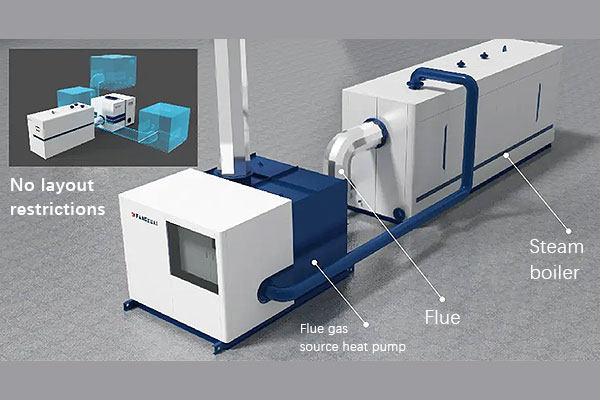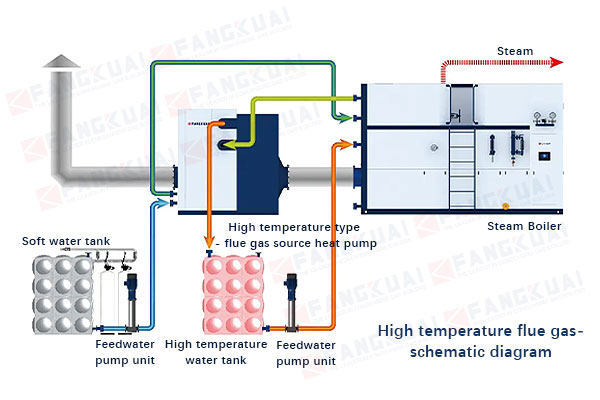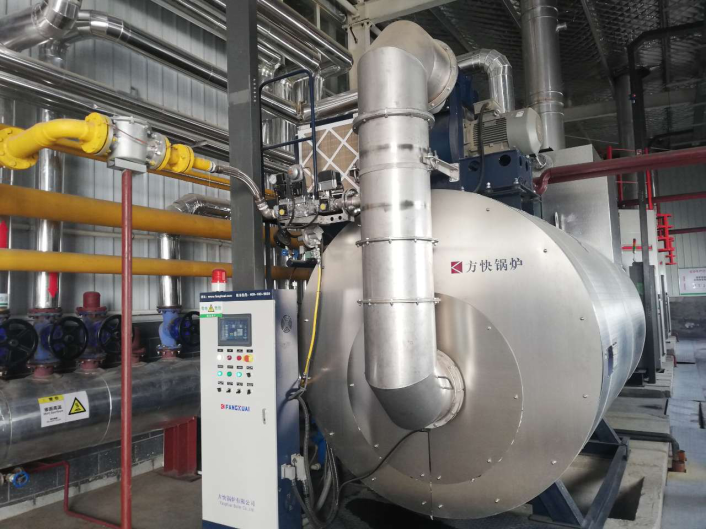What is a Flue Gas Source Heat Pump?
A flue‑gas‑source heat pump (FGSHP) pulls the low‑grade heat—usually below 150 °C—from boiler or industrial exhaust and “upgrades” it via a refrigerant cycle (evaporate → compress → condense → expand). By dropping exhaust temperatures to around 15–30 °C and reclaiming both sensible and latent heat, it delivers hot water or space heating at high temperatures while squeezing out every bit of energy from the fuel—efficiencies can exceed 110% on an LHV basis.
How Does It Work? The Thermodynamic Breakthrough
FGSHP leverages a multi-stage heat recovery process anchored in vapor-compression refrigeration principles:
-
Evaporation: The cold refrigerant flows through the evaporator, where it boils at around 30–60 °C by drawing heat from the flue gases.
-
Compression: The resulting vapour is sucked into the compressor, which cranks up its pressure—and its temperature climbs into the 70–90 °C range.
-
Condensation: Hot, high‑pressure vapour then moves through the condenser, dumping its heat into the water circuit (for things like space heating or domestic hot water).
-
Expansion: After condensing, the liquid refrigerant passes an expansion valve that drops its pressure and temperature, sending it back to the evaporator to repeat the process.
Critical Innovation: By using flue gas as the heat source instead of ambient air, FGSHP overcomes the winter efficiency collapse plaguing air-source heat pumps. The stable flue gas temperature (even at -30°C ambient) ensures year-round COP > 4.5.
Three Industrial-Grade FGSHP Architectures
1. Direct-Expansion FGSHP
- Mechanism: Refrigerant directly exchanges heat with flue gas in a corrosion-resistant cast silicon-aluminum evaporator. This achieves 20–30°C exhaust temperatures and >110% system efficiency.
- Advantages:
- Eliminates “white plumes” by condensing 91% of vapor.
- Reduces NOx by 10%+ via acid dissolution in condensate.
- Deployment: Ideal for industrial boilers and district heating.
- Case: Beijing residential project cut gas use by 360,000 m³/year and recovered 3,000 tons of condensate.
2. Screw-Drive FGSHP (Indirect)
- Design: Uses intermediate water loops to transfer heat from flue gas to a screw-compressor heat pump. Exhaust temperatures drop to <15°C with COP ≤ 7.0.
- Advantages:
- Delivers 65–75°C output water—ideal for process heating.
- Avoids high-pressure steam equipment certifications.
- Deployment: Hospitals, schools, and commercial complexes.
- Case: Beijing hospital reduced gas consumption by 21.5% with COP 4.73.
3. Centrifugal FGSHP (Indirect)
- Scale: Integrates plate heat exchangers with centrifugal compressors for 40–80 MW capacity. Exhausts at ≤30°C with primary-energy COP of 4–7.
- Advantages:
- Supports heating for 800,000 m² buildings.
- Annual CO₂ reductions up to 160,000 tons.
- Deployment: Gas-fired power plants and city-scale heating networks.
Why FGSHP Outperforms Traditional Systems
| Metric | Conventional Boiler | Condensing Boiler | FGSHP |
|---|---|---|---|
| Exhaust Temperature | 120–180°C | 40–60°C | 15–30°C |
| Fuel Utilization Efficiency | 85–90% (LHV) | 95–98% (LHV) | 105–110% (LHV) |
| NOx Reduction | None | Minimal | ≥10% |
| Water Recovery | None | Limited | 1.55 L/m³ gas |
Added ROI:
- 60% lower heating costs vs. gas boilers.
- Payback period: 1–4 years (varies by energy prices).
FAQs: Addressing Industry Skepticism
Can FGSHP handle acidic condensate corrosion?
Yes. Evaporators use silicon-aluminum alloy with 8–10× the thermal conductivity and corrosion resistance of stainless steel. Surface roughness promotes dropwise condensation, preventing scaling.
Does flue gas variability affect performance?
Variable-frequency compressors and adaptive controls maintain stable COP across 30–150°C flue gas fluctuations.
Is 15°C exhaust practically achievable?
Absolutely. Beijing projects consistently achieve 15–23°C exhausts, validated by third-party audits.
The Future Is Clear: Efficiency Beyond Condensation
Flue Gas Source Heat Pumps redefine energy recovery—transforming exhaust from a waste stream into a strategic asset. With >26% fuel savings, zero visible emissions, and ROI < 2 years, this technology isn’t just incremental improvement; it’s the next standard for industrial decarbonization.
Ready to maximize your energy assets? Contact our engineers for a site assessment.
Get your best price
Quickly compare 3 FREE quotes
- Engineer quick quote
- The overall delivery speed is fast
- Financial choice
- Low installation costs and cost savings
25 years+ of boiler R&D
More than 20 innovative technologies



